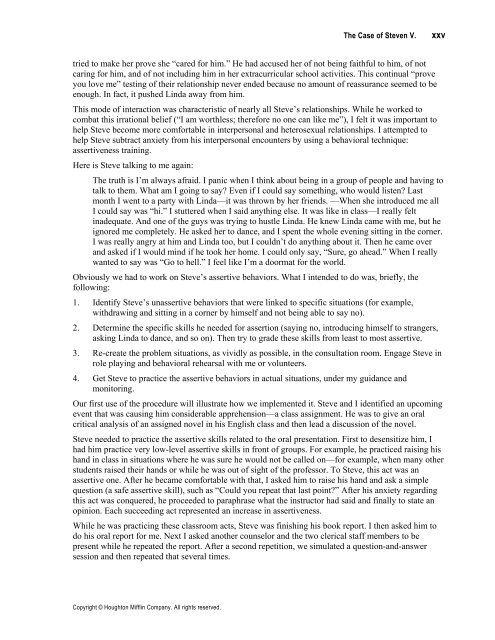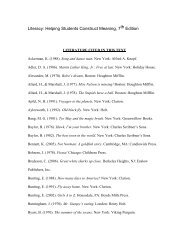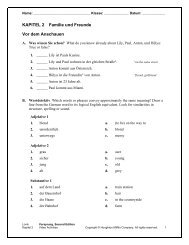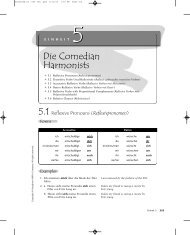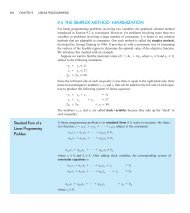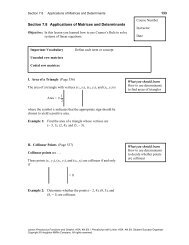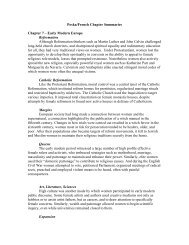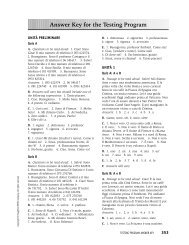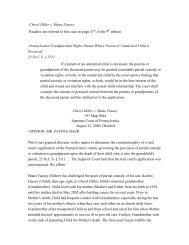Understanding Abnormal Behavior - Cengage Learning
Understanding Abnormal Behavior - Cengage Learning
Understanding Abnormal Behavior - Cengage Learning
You also want an ePaper? Increase the reach of your titles
YUMPU automatically turns print PDFs into web optimized ePapers that Google loves.
Copyright © Houghton Mifflin Company. All rights reserved.<br />
The Case of Steven V. xxv<br />
tried to make her prove she “cared for him.” He had accused her of not being faithful to him, of not<br />
caring for him, and of not including him in her extracurricular school activities. This continual “prove<br />
you love me” testing of their relationship never ended because no amount of reassurance seemed to be<br />
enough. In fact, it pushed Linda away from him.<br />
This mode of interaction was characteristic of nearly all Steve’s relationships. While he worked to<br />
combat this irrational belief (“I am worthless; therefore no one can like me”), I felt it was important to<br />
help Steve become more comfortable in interpersonal and heterosexual relationships. I attempted to<br />
help Steve subtract anxiety from his interpersonal encounters by using a behavioral technique:<br />
assertiveness training.<br />
Here is Steve talking to me again:<br />
The truth is I’m always afraid. I panic when I think about being in a group of people and having to<br />
talk to them. What am I going to say? Even if I could say something, who would listen? Last<br />
month I went to a party with Linda—it was thrown by her friends. —When she introduced me all<br />
I could say was “hi.” I stuttered when I said anything else. It was like in class—I really felt<br />
inadequate. And one of the guys was trying to hustle Linda. He knew Linda came with me, but he<br />
ignored me completely. He asked her to dance, and I spent the whole evening sitting in the corner.<br />
I was really angry at him and Linda too, but I couldn’t do anything about it. Then he came over<br />
and asked if I would mind if he took her home. I could only say, “Sure, go ahead.” When I really<br />
wanted to say was “Go to hell.” I feel like I’m a doormat for the world.<br />
Obviously we had to work on Steve’s assertive behaviors. What I intended to do was, briefly, the<br />
following:<br />
1. Identify Steve’s unassertive behaviors that were linked to specific situations (for example,<br />
withdrawing and sitting in a corner by himself and not being able to say no).<br />
2. Determine the specific skills he needed for assertion (saying no, introducing himself to strangers,<br />
asking Linda to dance, and so on). Then try to grade these skills from least to most assertive.<br />
3. Re-create the problem situations, as vividly as possible, in the consultation room. Engage Steve in<br />
role playing and behavioral rehearsal with me or volunteers.<br />
4. Get Steve to practice the assertive behaviors in actual situations, under my guidance and<br />
monitoring.<br />
Our first use of the procedure will illustrate how we implemented it. Steve and I identified an upcoming<br />
event that was causing him considerable apprehension—a class assignment. He was to give an oral<br />
critical analysis of an assigned novel in his English class and then lead a discussion of the novel.<br />
Steve needed to practice the assertive skills related to the oral presentation. First to desensitize him, I<br />
had him practice very low-level assertive skills in front of groups. For example, he practiced raising his<br />
hand in class in situations where he was sure he would not be called on—for example, when many other<br />
students raised their hands or while he was out of sight of the professor. To Steve, this act was an<br />
assertive one. After he became comfortable with that, I asked him to raise his hand and ask a simple<br />
question (a safe assertive skill), such as “Could you repeat that last point?” After his anxiety regarding<br />
this act was conquered, he proceeded to paraphrase what the instructor had said and finally to state an<br />
opinion. Each succeeding act represented an increase in assertiveness.<br />
While he was practicing these classroom acts, Steve was finishing his book report. I then asked him to<br />
do his oral report for me. Next I asked another counselor and the two clerical staff members to be<br />
present while he repeated the report. After a second repetition, we simulated a question-and-answer<br />
session and then repeated that several times.


